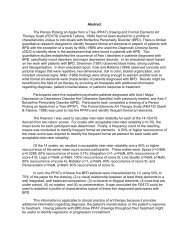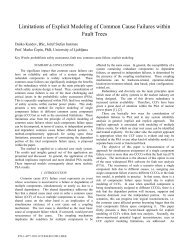Study of Ball Grid and Column Grid Array
Study of Ball Grid and Column Grid Array
Study of Ball Grid and Column Grid Array
You also want an ePaper? Increase the reach of your titles
YUMPU automatically turns print PDFs into web optimized ePapers that Google loves.
there is a difference between the CTE for the part <strong>and</strong> the<br />
support substrate or PWB material. This difference in CTE<br />
is known as CTE mismatch. The combinations <strong>of</strong><br />
temperature changes, due to external environment or power<br />
switching, <strong>and</strong> materials that possess different CTEs,<br />
produce substantial cyclic strains within the solder.<br />
SOLDER JOINT FATIGUE<br />
For traditional leaded parts, either Gull Wing or DIP,<br />
any board-to-part CTE mismatch is <strong>of</strong>ten absorbed by the<br />
leads themselves when they are properly formed (known as<br />
“compliant leads”) <strong>and</strong> very little tension load is applied to<br />
the solder. A practical limit for leaded device pin count is<br />
approximately 300 to 350 pins. As noted, to support the<br />
increased I/O requirements <strong>of</strong> current state-<strong>of</strong>-the-art<br />
devices, grid arrays (BGAs, CGAs) have been developed.<br />
There is a fatigue concern with grid array attachment<br />
because the parts are essentially soldered directly to the<br />
PWB with minimal lead compliance to absorb the thermal<br />
strain developed by the CTE mismatch between the part <strong>and</strong><br />
the PWB. When comparing <strong>Ball</strong> <strong>Grid</strong> <strong>Array</strong>s to <strong>Column</strong><br />
<strong>Grid</strong> <strong>Array</strong>s, CGAs provide a more robust design for thermal<br />
cycling environments by two means<br />
• The solder columns are typically designed to have a<br />
lower stiffness than a solder ball (sphere).<br />
• The solder column provides a higher st<strong>and</strong><strong>of</strong>f distance<br />
between the component <strong>and</strong> the board.<br />
These two features enable the column leads to flex with<br />
less stress as the dimensional expansion between the<br />
component <strong>and</strong> the board varies. The taller st<strong>and</strong><strong>of</strong>f will<br />
reduce the stress in the solder joint by approximately the<br />
square <strong>of</strong> the distance between the component <strong>and</strong> the board<br />
[2].<br />
While CGAs have slightly higher “lead compliance”<br />
than BGAs, the extra lead compliance <strong>of</strong> the solder column<br />
for Ceramic CGAs is <strong>of</strong>ten <strong>of</strong>fset by the larger CTE<br />
mismatch. Figure 2 illustrates the forces applied to the<br />
solder joints resulting from CTE mismatch <strong>and</strong> thermal<br />
excursions <strong>and</strong> Figure 3 shows an actual failed column joint<br />
following temperature cycling.<br />
2.1. Improving Solder Joint Robustness<br />
Matching the CTE as closely as possible reduces cycling<br />
stress <strong>and</strong> improves the reliability <strong>of</strong> the joints. However,<br />
there are trade<strong>of</strong>fs between selecting the best CTE<br />
compatibility matches <strong>and</strong> electrical performance. Examples<br />
<strong>of</strong> CTEs for common materials are shown in Table 1.<br />
A method to improve CTE mismatch is to use<br />
compatible PWB materials with a CTE closer to the<br />
component CTE. One such PWB material is known as<br />
Thermount TM . Another PWB material is Stablecore TM .<br />
Conversely, one can also use a ceramic with a higher CTE<br />
than the typical alumina compounds (Hi-CTE Ceramic).<br />
Unfortunately, not all PWB vendors have qualified processes<br />
for the special materials, <strong>and</strong> not all components are<br />
available in the Hi-CTE ceramics. Additionally, there is<br />
Figure 2. Forces Applied to the solder joints [3]<br />
Figure 3. Example <strong>of</strong> a Failed <strong>Column</strong> <strong>Grid</strong> <strong>Array</strong> [4]<br />
Table 1. CTE for Common Materials[5]<br />
Material CTE ≈<br />
PLASTIC BGA 15 ppm/°C<br />
Ceramic BGA Material 6.7 ppm/°C<br />
Hi-CTE Ceramic 10 ppm/°C<br />
Polyimide PWB Material 16 ppm/°C<br />
<strong>of</strong>ten a mix <strong>of</strong> component styles on boards <strong>and</strong> the use <strong>of</strong> one<br />
combination can have adverse effects on the other<br />
combination <strong>of</strong> materials. There are also several kinds <strong>of</strong><br />
solder columns available in the industry. Some have copper












